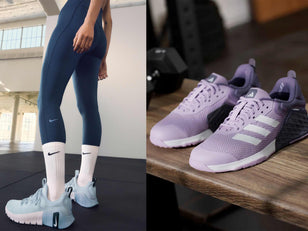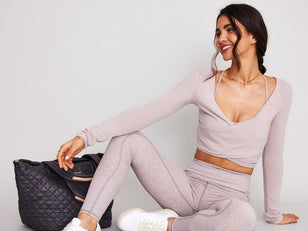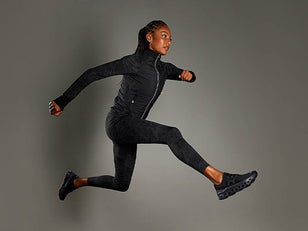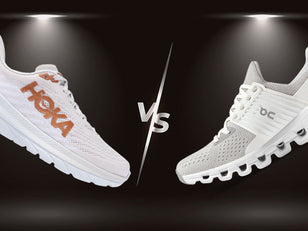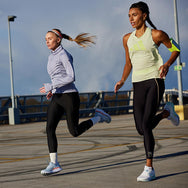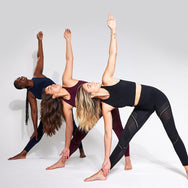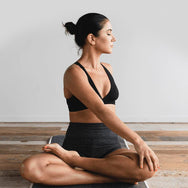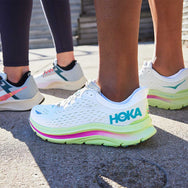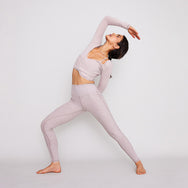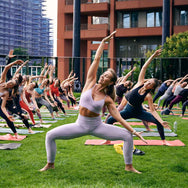Words by Chris Magee
The hip flexors are responsible for bringing your hip joint into flexion - i.e. moving your femur (thigh bone) forwards and up towards your abdomen.
WHAT ARE HIP FLEXORS?
The hip flexors comprise of two muscles:
- Psoas
- Illacus
The psoas muscle s is the bigger of the two and originates in your lower back. It travels through the crest of your pelvis - where the iliacus muscle joins the party - before both attach to the femur bone itself.

WHY DO HIP FLEXORS GET TIGHT?
Our hip flexors unfortunately bear the brunt of many modern day lifestyle factors. As such, it is very common to feel tightness in this area.
Sometimes we may feel tightness or painful sensations in the crease of the hip itself, but it is also possible that you may be noticing a stiffness and tightening in your lower back as well, due to the origin of the psoas muscle specifically.
The three causes below are the most common culprits for creating tightness in the front of the hips.
Any combination of these three may be causing your hip flexor pain. Ultimately, you will need to address your root causes as well as working with solutions such as hip flexor stretches to alleviate tightness and discomfort.
1: SITTING
We spend so much of our day sitting, whether it’s at work, travelling, eating or watching tv. All this habitual sitting keeps the hip joint in a constant state of flexion. This soon shortens the hip flexor muscles.
Although the hip flexors may not work very hard to achieve a flexed position when seated, it does give them a lot of time in this position. This can soon result in them becoming reprogrammed to think that this shortened, flexed length in the new normal. Subsequently when we stand and return the hip to a neutral position, we feel tension and tightness as the muscle no longer wants to lengthen towards its full range.
2: OVERTRAINING
As well as lifestyle factors, your training regime could play a part. A bombardment of repeated movement patterns with your hips in flexion, such as high impact endurance activities (e.g. running or cycling) or high energy HIIT workouts will easily increase tension in the hips through overtraining of the flexor muscles.
Unless this is negated by adequate recovery, time dedicated to improving strength and mobility of the hips and potentially seeking help from physiotherapists, hip flexor pain can soon become a persistent and painful problem.
3. MUSCULAR IMBALANCE
Muscular imbalance will develop if your training programme is missing a certain crucial element. Dominant use of the hip flexors is often a compensation for weakness elsewhere. As a result the hip flexors muscles really begin to feel the strain as they literally bear the load.
Strengthening your core, glutes, legs and improving your balance and flexibility are key areas of focus if you feel your hip flexor pain is a result of muscular imbalance.

THE BENEFITS OF STRONG HIP FLEXORS
Not only do we want the hip flexors to be flexible, we also want strong and mobile hips too. A combination of strength and flexibility is the way forward for the hip flexors and any muscle group we happen to be training or exploring, as it gives us the greatest freedom of movement and expression.
You want your hip to be able to perform fully through every action of the joint, and you also want to have the confidence that you can control your body and bring it back from that space at any time you choose.
By improving the strength and flexibility of your hips, you will create a sense of balance, safety and control within your body. This element of strength through the entire range of motion helps prevent injuries and discomfort, no matter what activity you are taking part in.
TOP 5 HIP FLEXORS STRETCHES
Now that we know what they are, their functional importance and how they may have become tight, it’s important to dedicate time to understand how to stretch your hip flexors.
These are some of my favourite variations to help you find length and strength:
1. Standing Quad Stretch
Probably a familiar stretch for most with a slightly different focus than we might be used to.
- While standing upright, bend one leg at the knee and catch hold of the foot or ankle behind you
- Draw the foot towards your glutes, using a wall or chair for balance if you need
- Once you are in this position stand tall, squeeze the glutes and try to create more length in your lower back
- Breathe deeply throughout
By squeezing the glutes and creating length in the back, you shift the focus from the quad and help the stretch travel up the hip flexors.
Aim for 60-90 seconds, then switch legs.

2. Twisted Lizard Variation
This pose is a yoga favourite, and can be modified as much as you need.
- Start in a kneeling lunge, with your left foot forward
- Place your right hand on the ground, in line with your left foot
- Allow your upper body to twist towards the left
- Reach your left hand back towards your left foot or ankle. If it isn’t possible to grab it, use a strap or a belt to create a loop around the foot and hold that instead
- Squeeze your left glute and create length in the lower back
- If you’d like to increase the intensity of the stretch, pull your foot left closer to the left glute
- If the sensation is too much, then allow the heel to travel away from the hips slightly
Hold for 60-90 seconds on each side.

3. Wall assisted Hip flexor stretch
For me, this is the king of all kneeling hip flexor stretches. However it can be very intense, so ease your way in.
- Lower into a lunge, with a wall close behind you
- Bend your back leg at the knee lifting your foot up towards the sky
- Allow the shin and foot to travel up the wall - note the closer your knee is to the wall itself the more intense the stretch will be
- It may feel more comfortable to pad the knee with a blanket or cushion underneath
- Press through the sole of the front foot firmly into the ground
- Keep your torso upright, with hands gently resting on the thigh of your front leg
- If you need to decrease the intensity, you can allow your torso to lean forward over the front thigh, in a slight diagonal line
- Gently squeezing the glute of the rear leg, aiming to create length in the lower back
- Breathe deeply throughout
Start small if you need. A great end goal would be to build up to 3 minutes before switching sides.
Sometimes focusing on time isn’t helpful, so maybe try counting your breaths instead - 15-20 deep breaths ought to do the trick.

4. Hip Flexor Strengthening
The one most of us hate and most of us need more of. You might not thank me at the time, but you will thank me later!
- Sit with your legs out in front of you - one bent, one extended
- Reach your hands out to frame the knee of your straight leg, leaning your chest over your thigh and creating a fold in your hip
- Maintaining the relationship between your torso and your leg, push gently through your hands and activate your hip flexor to lift your leg as high as you can without leaning backwards
- Lift, hold in the air for a count of 3, and lower back down with control. That’s one repetition - aim for 10 before switching legs or moving on
- Remember to breathe!
Too intense? Bring your hands a little closer to your torso, or allow your knee to bend.
Need more? Walk your hands closer to your ankle creating a deeper fold.

5. Supported Hip Extension
This move will feel amazing after the previous strengthening drill, or any point in time that you want to create space without having to be too active or energetic.
- Elevate your hips - I’m using a yoga block, but you could also use a bolster, pillows, stack of books - whatever you’ve got
- You should feel the support below your lower back and the back side of your pelvis. Adjust the height you lift your hips to, so that you don’t experience any discomfort in your back when you lie down
- Let your torso, arms and legs relax heavily
- Take deep slow belly breaths
Gravity does all the work for you in this one, so you just get to truly let go and relax. Because of that it's one of my favourite stretches to do before bed, or later in your day when you are looking to unwind.
Try it for at least 3-5 minutes to give the hips time to receive the full benefits. You can always stay longer if it feels good too.
New nap position anyone? Maybe just me…






















